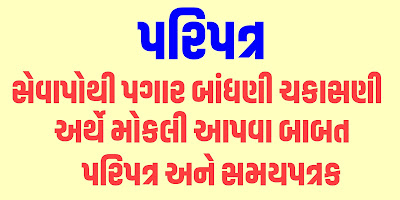Sevapothi Pagar Bandhani Chakasni Arthe mokli Aapva Babat circular
 JOIN US ON WHATSAPP
Join Now
JOIN US ON WHATSAPP
Join Now Sevapothi Pagar Bandhani Chakasni Arthe mokli Aapva Babat :Traditionally, businesses and other organizations have handled risk by transferring it to an insurance company through the purchase of an insurance policy or, alternatively, by retaining the risk and allocating funds to meet expected losses through an arrangement known as “self insurance,” in which firms retain rather than transfer risk.
During the liability crisis of the 1980s, when businesses had trouble obtaining some types of commercial insurance coverage, new mechanisms for transferring risk developed, facilitated by passage of the Product Liability Risk Retention Act of 1981. These so-called alternative risk transfer (ART) arrangements blend risk transfer and risk retention mechanisms and, together with self insurance form the alternative market.
Captives—a special type of insurance company set up by a parent company, trade association or group of companies to insure the risks of its owner or owners—and risk-retention groups—in which entities in a common industry join together to provide members with liability insurance—were the first mechanisms to appear. Other options, including risk retention pools and large deductible plans, a form of self insurance, followed.
ART products, such as catastrophe bonds, weather derivatives and microinsurance programs are also emerging as an alternative to traditional insurance and reinsurance product Wholly owned captives are companies set up by large corporations to finance or administer their risk financing needs. If such a captive insures only the risks of its parent or subsidiaries it is called a “pure” captive.
Captives may be established to provide insurance to more than one entity. An association or group of companies may band together to form a captive to provide insurance coverage. Professionals—doctors, lawyers, accountants—have formed many captives over the years. Captives may, in turn, use a variety of reinsurance mechanisms to provide the coverage. In particular, many offshore captives use a “fronting” insurer to provide the basic insurance policy. Fronting typically means that underwriting, claims and administrative functions are handled in the United States by an experienced commercial insurance company, since a captive generally will not want to get involved directly in running the insurance operation. Also, fronting allows a company to show it has an insurance.
Like risk retention groups (RRGs), purchasing groups must be made up of persons or entities with like exposures and in a common business. However, whereas RRGs are liability insurance companies owned by their members, purchasing groups purchase liability coverage for their members from admitted insurers, surplus lines carriers or RRGs. Laws in some states prohibit insurers from giving groups formed to purchase insurance advantages over individuals. However, purchasing groups are not subject to so-called “fictitious group” laws, which require a group to have been in existence for a certain period of time or require a group to have a certain minimum number of members. The Risk Retention
Act of 1986 specifically provided for purchasing groups to be created to purchase liability insurance for members of the sponsoring groups.Catastrophe Bonds and other Alternative Risk Transfer (ART) Products A number of alternative risk transfer (ART) products, such as insurance-linked
securities and weather derivatives have developed to meet the financial risk transfer needs of businesses. One such product, catastrophe (cat) bonds, riskbased securities sold via the capital markets, developed in the wake of hurricanes Andrew and Iniki in 1992 and the Northridge earthquake in that resulted in a global shortage of reinsurance (insurance for insurers) for such disasters. Tapping into the capital markets allowed insurers to diversify their risk and expand the amount of insurance available in catastrophe-prone areas. Zurich Financial’s Kamp Re was the first major catastrophe bond to be triggered.
The term “catastrophe” in the property insurance industry denotes a natural or man-made disaster that is unusually severe. An event is designated a catastrophe by the industry when claims are expected to reach a certain dollar threshold, currently set at $25 million, and more than a certain number of policyholders and insurance companies are affected.
The magnitude of the damage caused by Katrina and the potential damage Hurricane Rita might have caused had it not weakened from an intense Category 5 hurricane has triggered a reexamination, not just among insurers and reinsurers but also among public policy and political leaders, of how the United States deals with the financial consequences of such massive property damage and personal loss.
Disaster losses along the coast are likely to escalate in the coming years, in part because of huge increases in development. One catastrophe modeling company predicts that catastrophe losses will double every decade or so due to growing residential and commercial density and more expensive buildings. Data from the Census Bureau, collected by USA Today, show that in million people were seriously threatened by Atlantic hurricanes, compared with Man-made catastrophes such as the attacks on the World Trade Center can also cause huge losses. The attacks led Congress to pass the
Insurance Act (TRIA) in November Since then, TRIA has been reauthorized twice. The latest reauthorization, passed at the end of extends the law to . TRIA provides a federal backstop for commercial insurance losses from making it easier for insurers to calculate their maximum losses for such a catastrophe and thus to underwrite the coverage, see the topic on number to each catastrophe. Each claim arising from the event is tagged so that total industrywide losses can be tabulated. The term catastrophe is often used in the property insurance industry in a narrow way to mean a catastrophic event that exceeds a dollar threshold in claims payouts. This figure has changed over the years with inflation and the increase in development of areas subject .

Post a Comment